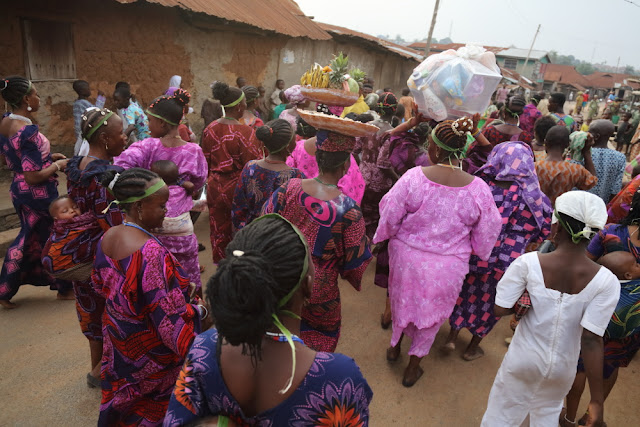 |
| Ladies in pink from the northern procession |
We participated to a procession from the compound of Ile Adedeji. The procession came from the North towards the palace of the Alaafin to pay him homage and it was joined by another one coming from the South. Both converged at the roundabout in front of the palace walls. The processions where essentially composed of women. The colour code of the southern one was pink while the northern one was blue and brown.
 |
| ladies in blue from the southern procession |
Three marquees were set-up, in
the middle of a ground delimited by mud-brick houses, providing shade to the guests
seated on plastic chairs around white plastic tables. Mostly men were seating
and chatting there, drinking beers (Goldberg, Star etc…) or soda. I was
introduced by Sangowale to his father, Chief Sangodele Ibuowo, the Elegun Sango of the Alaafin, who was chairing a table with a number of elders dressed
in their colourful celebration attires, Yoruba hats, embroidered or laced robes,
beaded necklaces and bracelets.
One of the mud-brick houses was
the centre of preparations. A public announcement unit with a cranky microphone
was used to make loud announcements and chants. The amplifier was put on a
plastic chair and the MC next sat next to it. Robust loudspeakers were directly
on the ground. A small veranda was hosting drummers who infused energy to the
place when they were playing.
As one entered the house, a
kitchen, on the right-hand side, was the place to prepare traditional ingredients for the rituals. The room had only one wooden table and the floor
as furniture.
Past the small entrance hall, one came into a large and
rather dark room which appeared to be the living room, opening on three other
rooms. The entrance of the shrine of Egbe, immediately on the right, was closed
by a white curtain and off-limits to non-initiates. Devotees would prostrate in
front of it on their knees and forehead touching the floor. Offerings were
lined-up in front of the curtain. A fruit basket and a bunch of long green
leaves, peregun leave, perhaps 70cm long. These would be used later on to form
green ribbons tied around the head of the procession devotees. On the left,
were two rooms, bedrooms most probably with mats on the floor and a bed. Opposite
the entrance was an opening to a small courtyard where clothes were hanged on
a cord. It also hosted a shrine to Ogun, the divinity of iron. It looked like a
contemporary sculpture of metal as it is made of various metal pieces, bicycle
chain, knifes, picks and other tools… and is regularly fed with palm oil and
other ingredients poured over it.
The afternoon golden sunlight was
bathing the living room from courtyard entrance. Women sat on mats in the
middle of the room chatting, some carrying babies on their back. Very
young boys were lying on the mats too, relatively quiet.
 |
| make-up before the procession |
Around 4PM, as the heat had
receded a bit, women assembled, dressed in their new pink and purple outfits, and were tying the green peregun ribbons around their heads. They sung and danced
barefoot some religious and traditional chants at the rythm of the drums. Each
of the women would salute the procession leader.
Three women carried offering
baskets on their head. One had fruits, the second one Ekuru (white beans cake) and the last one a
large hamper of daily house goods and toys wrapped in a white veil.
Everything was now set to go, the
procession started happily on the streets. Onlookers reacted differently, some
waving and smiling others looking on with wary looks, some blocking their ears
as if the noise of the chants and drums were pollutions. Traffic was slowed
down to create space for the procession on its way to the Alaafin's palace.
 |
| dancing in the street |
After a while of dancing, the
processions walked back to their respective compound before breaking ranks. One of
the songs along the way was “buy me sugar cane”. Someone had brought some fresh
sugar cane chunks and was selling them.

Comments
Post a Comment